Author: Zack Pokorny Translation: Deep Tide TechFlow
The growth of RWAs and the introduction of new types of RWAs on the chain are mainly driven by the demand of native crypto users, rather than new crypto adopters.

There are several different types of RWAs on the blockchain, each with its own characteristics, serving different use cases. While certain types of RWAs such as stablecoins and tokenized gold have been around for years, other types of RWAs such as US Treasury Bonds have recently emerged against the backdrop of rising interest rates. This article will briefly outline the following types of income-generating RWAs:
- Vitalik’s latest research How to resolve the risks brought by a large number of double staking in Ethereum?
- In-depth Analysis of STARK’s Complete Security
- Ordinals gameplay upgraded again, both speculation and artistry flourish.
-
Real Estate
-
Private Credit
-
Treasury Bonds
Note: The following analysis focuses on these tokenized assets of RWAs and their market value. This report does not include information about underlying protocols (such as Ethereum, Polygon, Stellar, etc.) that build RWAs or auxiliary blockchain-native services that support RWA transactions and financial management. In addition, the report does not involve stablecoins (which have the largest market share and the longest history among RWAs, with a value of $125 billion) in the charts and RWA TVL calculations in order to avoid overshadowing the growth of smaller market cap RWAs or underestimating the driving force behind RWAs.
Integrating the Real World with the Digital World
RWAs are created by issuers who perform one or more of the following activities:
-
Acquiring assets in the real world
-
Tokenizing these assets on the chain
-
Distributing RWA tokens to on-chain users
RWAs would not exist on the chain without issuers, whether they are centralized companies, decentralized protocols, or a combination of both.
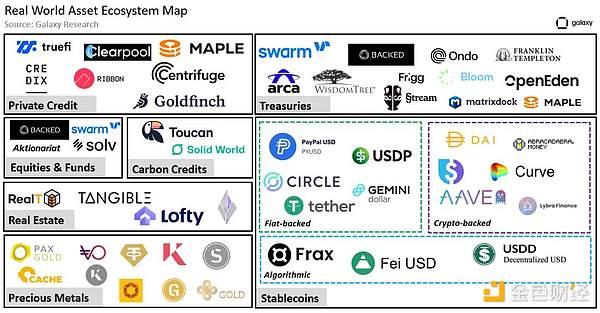
Some notable RWA issuers include:
-
Centrifuge (active RWA issuance value of $238 million) – the largest on-chain private credit issuer.
-
Franklin Templeton (active RWA issuance value of $310 million) – a traditional financial institution issuing tokenized government bonds.
-
Wisdom Tree (active RWA issuance value of $11 million) – an institutional capital market for issuing treasury tracking funds
This short list, along with other issuers shown in the above figure, highlights the situation of off-chain entities endorsing on-chain RWAs. Franklin Templeton and WisdomTree are two experienced traditional financial companies whose primary business is unrelated to cryptocurrency and blockchain technology. Franklin Templeton is a global investment firm with a 76-year history, providing individuals and institutions with mutual funds, ETFs, and other fund products. As a company, Franklin Templeton manages over 100 ETFs and mutual fund products with assets under management totaling $1.5 trillion. WisdomTree is a global financial innovation company established in 1985. The company offers diversified exchange-traded products (ETPs), models, and solutions. WisdomTree manages assets totaling $95.948 billion.
In the past few years, Franklin Templeton and WisdomTree have begun to explore RWA, tokenizing various traditional financial instruments such as tokenized equity funds and government bonds to meet the needs of institutional clients. Although these efforts are still in the early stages, the move by traditional financial companies to issue RWAs has the potential to catalyze a large number of new users who have never been exposed to the blockchain to enter the cryptocurrency space.
Growth of Yield-Generating RWAs
As of September 30th, the market value of RWAs reached $2.49 billion, a 9.6% decrease from the peak of $2.75 billion set on April 19th. Despite strong growth in government bond-related RWAs, the issuance of private credit by active loan originators over the past 18 months has decreased significantly, resulting in the market value of RWAs being below its all-time high.

From January 31st to September 30th, the value of non-stablecoin RWAs increased by $1.05 billion. Of the $855.7 million in new growth over the past three quarters, it came from government bonds and other bonds, real estate, and private credit.

Private Credit
Private credit is a form of lending provided by non-bank institutions. Since the 2008 financial crisis, banks have faced increasing regulations, and the private credit market has experienced significant growth as borrowers seek alternative sources of capital. This trend has further expanded in the current interest rate cycle, with bank balance sheets being particularly constrained (as evidenced by bank failures earlier this year). Private credit solutions benefit both borrowers and lenders. It provides borrowers with the flexibility that traditional bank loans lack, and its floating interest rate provides lenders with interest rate protection that fixed-rate alternatives do not offer. As of August 2023, the global private credit loan market is valued at $15 trillion.

From January 1st to September 30th, the active value of on-chain private credit loans increased by $210.5 million (84% growth). The majority of the growth (74%) came from Centrifuge, which saw an increase in outstanding loan balances of $155.7 million. Clearpool, a decentralized credit marketplace, experienced the largest relative change over the past three quarters. From January 1st to September 30th, the platform’s loan balance grew by 966% to reach $23.96 million by September 30th. Clearpool has cumulatively issued over $400 million in private credit loans across three chains (Polygon, Polygon zkEVM, and Ethereum) throughout its lifecycle.
Despite the growth in 2023, the total value of on-chain private credit loans represented is still 70% lower than the all-time high of $1.54 billion reached in May 2022. As the Federal Reserve significantly raises interest rates, active loans have decreased significantly, and yields have risen in the nine months since the first rate hike in March 2022.

Users can obtain significantly higher profits by using stablecoins for on-chain private credit loans compared to the profits obtained by using stablecoins in DeFi lending protocols such as Aave and Compound. From January 1st to September 30th, the average daily interest difference between the tokenized returns of on-chain private credit loans and the weighted average stablecoin supply rates of Aave and Compound was 7.7%. The stablecoin deposit interest rate is calculated based on the weighted average of the borrowed amount of assets on Aave and Compound:

It is worth noting that there are different risk situations when depositing stablecoins into decentralized lending protocols such as Aave and Compound compared to depositing them into platforms like Centrifuge and Clearpool that provide tokenized real-world private credit loans. Most loans on decentralized lending protocols are overcollateralized, so there may not be tokens representing private credit loans.
Real Estate
Real estate is a tangible asset class that includes properties such as residential buildings, commercial buildings, and land. Real estate is particularly attractive to investors because of its potential for positive cash flow through passive income streams such as rental income. In 2023, real estate is the largest asset class in the world with a value of approximately $613 trillion.
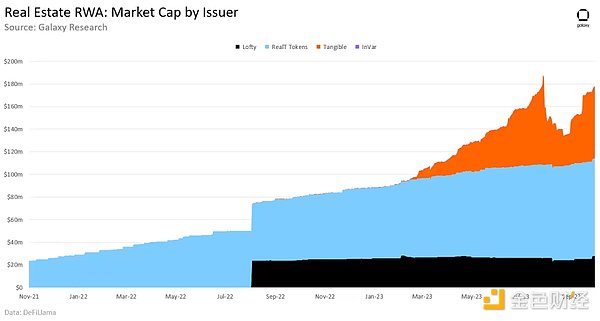
Among all the revenue-generating RWA categories covered in this report, on-chain real estate has the least growth in USD terms. From January 1st to September 30th, the total value of these tokenized assets was $178 million, representing ownership stakes in real estate in some cases. RealT is the largest issuer of tokenized real estate, accounting for 49% of the market share. Tangible is another key RWA issuer in the real estate sector and has shown the strongest growth this year. The total value locked in Tangible tokens increased from $100,000 to $64 million in the first three quarters of 2023.
Sovereign Bonds and Other Bonds
US Treasury bonds are debt securities guaranteed by the government. They are widely considered the safest and most reliable type of income-generating asset, often referred to as “risk-free” (although there is the risk of default by the US government). In contrast, corporate bonds are debt securities issued by companies that offer potentially higher returns but also carry greater risks compared to government bonds. In 2022, the global bond market was valued at $133 trillion, and US corporations alone issued $10.2 trillion in corporate bonds in the first three quarters of 2023.
The value of tokenized sovereign bonds and other bonds increased by $557.05 million from January 1st to September 30th. Ondo Finance, Franklin Templeton, and Matrixdock are the top 3 sovereign bond RWA issuers. They collectively issued $572.05 million in assets (accounting for 85% of the tokenized sovereign bonds and other bonds category) and issued $468.5 million in sovereign bond RWA this year.
Frigg.eco is different from other issuers in this category as it issues bonds related to sustainable infrastructure developers. These instruments are more like corporate bonds rather than sovereign bonds issued by other issuers. The bonds issued by Frigg.eco allow token holders to earn profits by providing funds for development and allow developers to issue debt to fund their initiatives.
Another tokenized treasury asset with a market value of approximately $1.8 billion is stUSDT. stUSDT is the first RWA project launched on the Tron network. Recently, this asset has been criticized for its lack of transparency in terms of support and revenue sources.
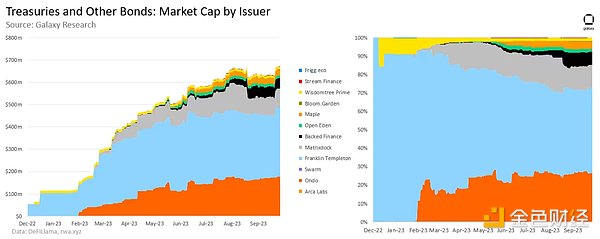
Over the past 18 months, the average yield of US Treasury bonds with a maturity of less than 3 years (the most widely used maturity on-chain) has consistently been higher than the average yield of stablecoin deposits. In 2023, the average daily interest rate difference between these bonds and the weighted average interest rates of Aave and Compound stablecoins is approximately 3% (Treasury bond rate – on-chain rate). In comparison, the average interest rate difference between Moody’s AAA corporate bonds and on-chain stablecoin rates is 2.7% (corporate bond rate – on-chain rate).
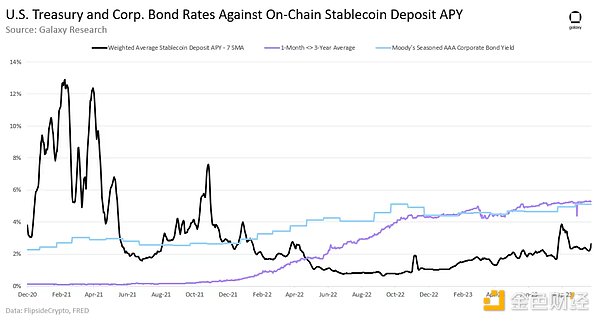
Outlook
The demand for returns from local cryptocurrency users is driving the growth of on-chain RWA. Approximately 82% of the new value created in the RWA sector this year comes from income-generating RWAs such as tokenized private loans, real estate, and treasury bonds. In terms of total RWA market value, the share of income-generating RWAs has nearly doubled from 31% on January 1 to September 30, reaching 53% (4% away from the historical high of 57%), compared to non-income-generating RWAs such as gold, stocks, and carbon offsets.
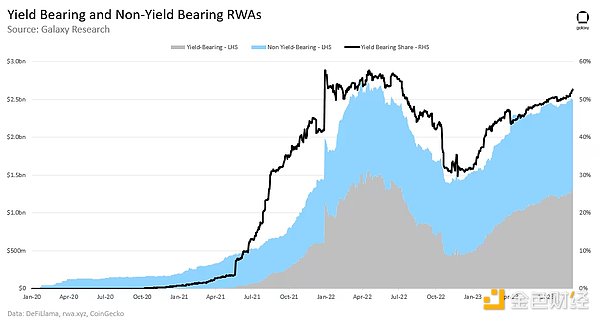
Between 2021 and 2023, the proactive shift in monetary policy by the Federal Reserve will raise benchmark interest rates to levels not seen since 2007. This creates new demand for RWA native decentralized finance users seeking higher returns.
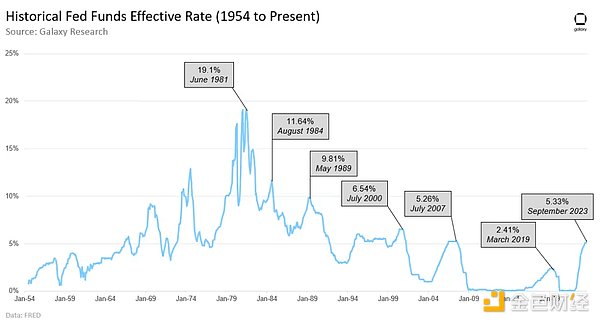
Most RWA users are crypto-native users
The majority of on-chain RWA demand comes from a small number of crypto-native users, rather than new crypto adopters or traditional investors. The average creation time of user addresses interacting with RWA tokens is earlier than the creation time of these assets on-chain, highlighting that the average RWA holder has been transacting on-chain for some time.
The chart below shows the age of unique user addresses holding RWA tokens issued by the following companies and protocols. The token symbols for these assets that issued RWAs are as follows (in parentheses). These assets collectively account for nearly 70% of the income-generating RWA TVL:
-
Ondo (OUSG)
-
Matrixdock (STBT)
-
Maple (MPLcashUSDT and MPLcashUSDC)
-
Open Eden (TBILL)
-
Backed (bIB01 and bIBTA)
-
Arca Labs (RCOIN)
-
WisdomTree (WSTY)
-
Swarm (TBONDS13 and TBONDS01)
-
Stream Finance (US4W)
-
Bloom (TBY-Feb1924, TBY-mar24 (a), and TBY-mar24 (b))
-
Franklin Templeton (FOBXX)
Note: The snapshot of these asset holders was taken on August 31, 2023. Therefore, the age calculation of the addresses is the number of days between the address’s first on-chain transaction and August 31, 2023. For users who hold multiple RWAs, the age is calculated once for their address. Multiple addresses determined to be controlled by a single user are also counted once, using their earliest transaction. The data tracks the age of all on-chain addresses where these assets are issued, including Ethereum, Stellar, and Polygon. The following data also shows the age of user addresses representing the tokenized representation of private credit issued by the following three protocols:
-
Clearpool on Ethereum and Polygon zkEVM
-
Maple on Ethereum
-
Goldfinch.

As of August 31, 2023, a total of 3,232 unique addresses hold the RWA assets issued by the aforementioned companies and protocols. The average age of addresses that hold and interact with RWAs is 882 days, or 2.42 years. This means that, on average, addresses have been on-chain since April 2021. In comparison, the average age of RWA assets is 375 days. For tokenized treasury assets, the age calculation of these RWAs is the number of days between the first token minting day and August 31, 2023. For assets issued by private credit platforms like Clearpool, Maple, and Goldfinch, the age is calculated based on the number of days from the protocol launch date to August 31, 2023. For private credit RWA assets, using the protocol launch as the start date for the age of these assets can compensate for the rolling nature of on-chain private credit (i.e., loan expiration/pool closure, new loan opening).
20% of the addresses that interact with or hold the aforementioned RWAs have been conducting on-chain transactions since 2023, over three years before the rise of RWA assets on-chain. The following table summarizes the age range of user addresses holding RWAs as of August 31, 2023:
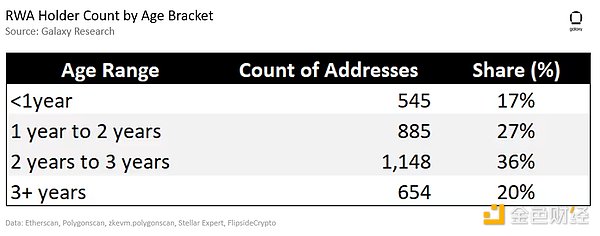
Many of the RWA holders who executed their first transaction less than a year ago, as highlighted above, are holders of RWAs issued by Franklin Templeton and WisdomTree (34%, 188 addresses). This indicates that RWA products created by established financial companies may be successfully attracting new user groups to enter the crypto space, although the majority of RWA users still seem to be native crypto users.
RWAs Represent Real-World Risks and Limitations
Although many RWAs are issued on public blockchains, they do not provide users with unrestricted access to financial products and services. In most cases, users interacting with RWAs on-chain are required to complete KYC/AML or whitelist verification, undergo credit checks, and may need to meet minimum balance requirements to mint, purchase, deposit, and/or redeem RWAs. RWAs are subject to similar or, in some cases, more restrictions than their traditional financial counterparts. This means that RWAs do not expand access to financial instruments by allowing individuals to participate in activities they would otherwise not have access to.
In addition, RWAs face unique risks beyond the technical risks associated with all on-chain applications and services. For example, since private credit lending is unsecured in certain cases in traditional finance, the tokenized representation of private credit loans must also reflect this reality. If an off-chain borrower defaults on their loan, the on-chain depositors may lose their funds. To compensate for such risks on-chain, RWA private credit issuers must find a way to review new loans within the risk/reward range and through the transparent governance process of decentralized autonomous organizations (DAOs) to facilitate asset allocation.
The Importance of Federal Reserve Policy
The actions of the Federal Reserve greatly influenced the popularity of RWAs this year. With interest rates rising, off-chain returns became more attractive to on-chain users. Additionally, as interest rates increased, the most valuable types of RWAs also changed. For example, in the second quarter of 2022, private credit-backed RWAs accounted for 56% of the total RWA TVL, while US Treasury-backed RWAs accounted for 0%. In the third quarter of 2023, the share of private credit-backed RWAs in total RWA TVL declined to 18%, while the share of US Treasury-backed RWAs increased to 27%. Federal Reserve policy is a driving force behind the expansion and layout of the RWA DeFi sector.
Conclusion
The growth of RWAs and the introduction of new types of RWAs on-chain are mainly driven by the demand of native crypto users, rather than new crypto adopters. However, the adoption of RWAs by major traditional financial companies such as Franklin Templeton and WisdomTree demonstrates the potential of this emerging DeFi field to attract future new users. RWAs in 2023 have strong momentum, and the market value of many such assets is trending towards new all-time highs. The evolving macro environment will continue to influence the development of this field, as will the ongoing demand for these types of assets from both native and non-native crypto users.
Like what you're reading? Subscribe to our top stories.
We will continue to update Gambling Chain; if you have any questions or suggestions, please contact us!